

Originally the rating was ECE 22, we are now at version 5. The minimum standard, as outlined by the ECE, goes through standard updates when the organization feels it's time for improvement. The Economic Commission for Europe (ECE) is Europe's standard of testing to qualify a motorcycle or scooter helmet as safe for street use. *Check the handy chart made up by SNELL where they compare their testing scenario to DOTs. Getting the best available safety gear is important. So if you want to be sure your helmet is DOT rated, buy a SNELL helmet, and you'll get both. SNELL claims that their testing meets the minimum DOT standard as well as their own level. DOT set the maximum to 400 G's & SNELL set theirs to 300 G's, each with a different measurement of impact time. When it comes to testing, DOT & SNELL both measure impacts against contact with an anvil via G-force. I'm sure MIPS will have a very scientific For this reason, it is perhaps best to stick with what has stood the test of time. It is worth noting in a 2018 test, SNELL shows no performance gain with the addition of MIPS. This is in contrast to a DOT helmet where manufacturers can authorize their own rating. To sell a SNELL certified helmet, manufacturers need to apply for testing, then have their helmets approved by SNELL before they can obtain certification and sell with this rating. They claim that "SNELL standards are the world's toughest." SNELL, however, makes the claim that they are a better testing system. You could argue that one helmet rating is better than another, but I'm in no position to claim who's best. There is an in depth video that outlines the problem with this system and shows an average of 20% failure rate with this system, and points towards a dishonest line of manufactures that are left to self-police. All DOT helmets are innocent until proven guilty. DOT then chooses helmets at random from store shelves for testing to see if they, in fact, do meet the requirements. Basically, helmet manufactures self-determine if their helmets meet these standards and if they feel that is the case, they add the DOT sticker onto the helmet and sell them with this rating. Second, the DOT system is an honor system. The problem(s)? First off, this standard has never had a significant overhaul since 1972, and in the opinion of many, it should be updated to meet more rigorous safety standards. These various impact levels are determined by DOT. To be a DOT rated helmet, you must meet a minimum requirement for absorbing shock impact, resisting penetration from an impact, and have a chin strap that won't unsafely stretch. This DOT sticker is the most commonly seen sticker on helmets in the US and often seen on helmets the world over.

The United States Department of Transportation (DOT), sets the minimum standard for testing before a helmet can be sold. Without these recognized standards, a user would be unable to know the difference in safety from one helmet to the next, or if the helmet adheres to any kind of standards. In Europe and the US these standards known as DOT, ECE, MIPS, & SNELL all account for slightly different ratings for street helmets, but all work towards the same goal of improved safety. To account for this wide variety of head smashing variables, ratings tests were designed and tested, and now make up helmet rating standards. On a motorcycle, the variables of how your head might impact anything from the ground to a handlebar or even a vehicle are extremely more vast than the car/seat belt scenario. In a car, the seat belt holds you back, and an airbag catches you. In the unfortunate possibility of a motorcycle accident where the riders head comes into contact with other objects, the way the helmet is designed can literally save your life.


 0 kommentar(er)
0 kommentar(er)
